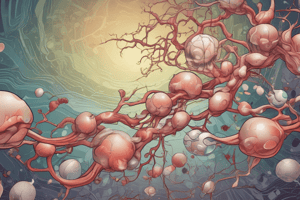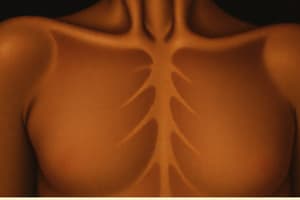Podcast
Questions and Answers
What is the main approach used to evaluate the endocrine system?
What is the main approach used to evaluate the endocrine system?
- Assessing patient symptoms only
- Measuring hormone concentrations (correct)
- Imaging of endocrine glands
- Genetic testing of hormone receptors
Which of the following conditions is categorized as a hormone deficiency disorder?
Which of the following conditions is categorized as a hormone deficiency disorder?
- Graves' disease
- Cushing's syndrome
- Diabetes mellitus Type 2
- Primary hypothyroidism in Hashimoto's thyroiditis (correct)
Which condition is characterized by hormone deficiency states often due to glandular destruction?
Which condition is characterized by hormone deficiency states often due to glandular destruction?
- Endocrine hypofunction (correct)
- Adrenal crisis
- Hypoparathyroidism
- Hyperthyroidism
What might a high-pitched voice in a male patient indicate?
What might a high-pitched voice in a male patient indicate?
What is a common cause of hormone resistance syndromes?
What is a common cause of hormone resistance syndromes?
What syndrome is associated with mutations in the androgen receptor leading to female phenotypic appearance in XY males?
What syndrome is associated with mutations in the androgen receptor leading to female phenotypic appearance in XY males?
Which is NOT a cause of glandular destruction leading to hormone deficiency?
Which is NOT a cause of glandular destruction leading to hormone deficiency?
What is the typical treatment method for hormone excess conditions?
What is the typical treatment method for hormone excess conditions?
What can potentially cause endocrine hyperfunction of a gland?
What can potentially cause endocrine hyperfunction of a gland?
How can hair growth patterns contribute to medical diagnosis?
How can hair growth patterns contribute to medical diagnosis?
What is a common cause of tissue hypersensitivity to hormones?
What is a common cause of tissue hypersensitivity to hormones?
Which treatment is typically used for hypofunction disorders in endocrine treatment?
Which treatment is typically used for hypofunction disorders in endocrine treatment?
What is a common presenting symptom of diabetes mellitus?
What is a common presenting symptom of diabetes mellitus?
In assessing gonadal status, which physical characteristic is a sign of androgen excess in females?
In assessing gonadal status, which physical characteristic is a sign of androgen excess in females?
What symptom is NOT typically associated with Cushing’s syndrome?
What symptom is NOT typically associated with Cushing’s syndrome?
Which of the following findings is a key indicator of hypothyroidism?
Which of the following findings is a key indicator of hypothyroidism?
Which hormone levels should be particularly noted in females during the examination of adenarche, thelarche, and menarche?
Which hormone levels should be particularly noted in females during the examination of adenarche, thelarche, and menarche?
What physical characteristic is often associated with Cushing's disease?
What physical characteristic is often associated with Cushing's disease?
How is secondary endocrine disease primarily identified?
How is secondary endocrine disease primarily identified?
Which statement correctly describes primary endocrine disease?
Which statement correctly describes primary endocrine disease?
Which endocrine condition is most prevalent in populations with iodine deficiency?
Which endocrine condition is most prevalent in populations with iodine deficiency?
What is a crucial step when taking a history from a patient suspected of having an endocrine disorder?
What is a crucial step when taking a history from a patient suspected of having an endocrine disorder?
Which of the following is considered a potential cause of hormone overproduction?
Which of the following is considered a potential cause of hormone overproduction?
What is the primary goal of dynamic testing in endocrine evaluations?
What is the primary goal of dynamic testing in endocrine evaluations?
What is the purpose of urinary hormone determinations in clinical evaluations?
What is the purpose of urinary hormone determinations in clinical evaluations?
Which symptom is an early indication of a possible endocrine disorder, specifically suggestive of diabetes?
Which symptom is an early indication of a possible endocrine disorder, specifically suggestive of diabetes?
When are radiologic imaging tests like CT and MRI typically utilized in diagnosing endocrine disorders?
When are radiologic imaging tests like CT and MRI typically utilized in diagnosing endocrine disorders?
What role do drugs that reduce hormone resistance play in endocrine therapy?
What role do drugs that reduce hormone resistance play in endocrine therapy?
What is a fundamental requirement for detecting subtle symptoms and signs of underlying endocrine disease?
What is a fundamental requirement for detecting subtle symptoms and signs of underlying endocrine disease?
What symptom is most commonly associated with excessive ACTH production?
What symptom is most commonly associated with excessive ACTH production?
In the physical examination for endocrine disorders, what factor is least likely to be assessed?
In the physical examination for endocrine disorders, what factor is least likely to be assessed?
Which symptoms are commonly associated with hyperthyroidism?
Which symptoms are commonly associated with hyperthyroidism?
What aspect of physical examination is crucial for accurately diagnosing endocrine disorders?
What aspect of physical examination is crucial for accurately diagnosing endocrine disorders?
Which of the following findings can be associated with hormone deficiency?
Which of the following findings can be associated with hormone deficiency?
Which condition can cause compression of surrounding structures in the thyroid gland?
Which condition can cause compression of surrounding structures in the thyroid gland?
What could excessive body hair in females indicate?
What could excessive body hair in females indicate?
In a male with a full beard who has fathered children, which of the following can be ruled out?
In a male with a full beard who has fathered children, which of the following can be ruled out?
Flashcards are hidden until you start studying
Study Notes
Introduction to Endocrinology
- Endocrinology focuses on hormone secretion, action, and feedback control.
- Hormone concentrations are used for evaluating the endocrine system.
- Most endocrine disorders respond to treatment once diagnosed.
Pathologic Mechanisms of Endocrine Disease
- Endocrine diseases are categorized into three main types: hormone excess, hormone deficiency, and hormone resistance.
Endocrine Pathology
- A primary disease arises from a gland itself (e.g., Hashimoto's thyroiditis leading to primary hypothyroidism).
- Abnormal stimulation of a gland by the pituitary is categorized as a secondary disease (e.g., secondary hypothyroidism due to pituitary tumor).
- Common endocrine diseases include thyroid gland disorders, reproductive system diseases, and diabetes mellitus.
Causes of Endocrine Hyperfunction
- Pituitary overstimulation, either intrinsically or by the hypothalamus, can cause endocrine gland hyperfunction.
- Gland hyperplasia or neoplasia frequently contributes to hyperfunction.
- Ectopic hormone production from cancers in other tissues can also lead to hyperfunction.
- Exogenous hormone administration can cause hormone excess.
- Nonprescription hormonal products may be unknowingly consumed by patients leading to hormone excess.
- Tissue hypersensitivity to hormones can occur, as seen in Graves' disease, where antibodies stimulate the thyroid gland.
- Abrupt release of stored hormones, such as thyroid hormone during subacute thyroiditis, can cause hyperfunction.
- Enzyme defects in hormone synthesis can lead to overproduction of hormones proximal to the block.
- Overproduction of a hormone can occur as a physiological response to a disease state.
Causes of Endocrine Hypofunction
- Glandular destruction caused by autoimmunity, surgery, infection, inflammation, infarction, hemorrhage, or tumor infiltration are major causes of hormone deficiency.
Causes of Hormone Resistance
- Mutations in hormones, receptors, transcription factors, and enzymes can lead to hormone deficiencies.
- Inherited defects in receptors, nuclear receptors, or signaling pathways are often responsible for severe hormone resistance syndromes.
- These syndromes result in defective hormone action despite increased hormone levels.
- Complete androgen resistance, caused by mutations in the androgen receptor, results in a female phenotype in XY males.
History Taking in Endocrine Disorders
- Approach each patient as a possible case of endocrine disorder to avoid missing diagnoses.
- Patients with one endocrine disease are at higher risk for developing others.
- Patients may have multiple endocrinopathies, which could be overlooked.
- Pay attention to the patient's feelings and concerns.
- Review the history from head to toe, including vocal pitch, hair growth, and family history.
- Mental changes, fatigue, muscle weakness, bruising, infections, stretch marks, and acne could indicate Cushing's syndrome.
- Investigate the pituitary gland through history, physical examination, and radiographs.
- Assess menstrual history in females, including amenorrhea, which could indicate hypothalamic-pituitary–ovarian axis dysfunction.
- Examine the presence and history of facial hair in males for assessing gonadal status.
- Excessive body hair in females could indicate androgen excess.
- Monitor for signs of thyroid dysfunction, including fatigue, weight loss, constipation, nervousness, tremors, heat intolerance, difficulty concentrating, and insomnia.
- Evaluate for symptoms of diabetes mellitus, such as excessive thirst, urination, nocturia, weight loss, increased appetite, blurred vision, frequent infections, numbness or pain in extremities, and nonhealing ulcers.
Physical Examination in Endocrine Disorders
- Focuses on manifestations of hormone excess or deficiency, including examination of palpable glands like the thyroid and gonads.
- Endocrine illnesses affect almost every organ system.
- Central obesity, skin striae, and proximal muscle weakness are characteristics of Cushing's syndrome.
- Mental slowing, fatigue, dry skin, and other features of hypothyroidism can be subtle.
- Observe body size, habitus, and fat distribution for clues about hormonal status and possible Cushing's syndrome.
- Examine the scalp and facial hair for assessing gonadal status.
Laboratory Investigations in Endocrine Disorders
- Most hormone measurements are based on plasma or serum samples.
- Urinary hormone determinations are useful for evaluating certain conditions.
- Urine collections over 24 hours provide an integrated assessment of hormone production.
- Dynamic tests like ACTH stimulation or dexamethasone suppression are used for assessing organ function.
- Imaging techniques like CT scans, MRI, thyroid scans, and ultrasound are used for diagnosing endocrine disorders, usually after hormonal abnormalities are identified.
- Biopsy and Fine Needle Aspiration Cytology are used for pathological analysis.
Treatment of Endocrine Disorders
- Hormone replacement therapy is used for hypofunction disorders.
- Hormone production suppression is employed for hyperfunction disorders.
- Radiation therapy and surgery are options for treating hyperfuction disorders.
- Drugs that reduce resistance can be used for hormone resistance.
- Hormone-stimulating drugs are sometimes used to enhance hormone production.
Studying That Suits You
Use AI to generate personalized quizzes and flashcards to suit your learning preferences.




